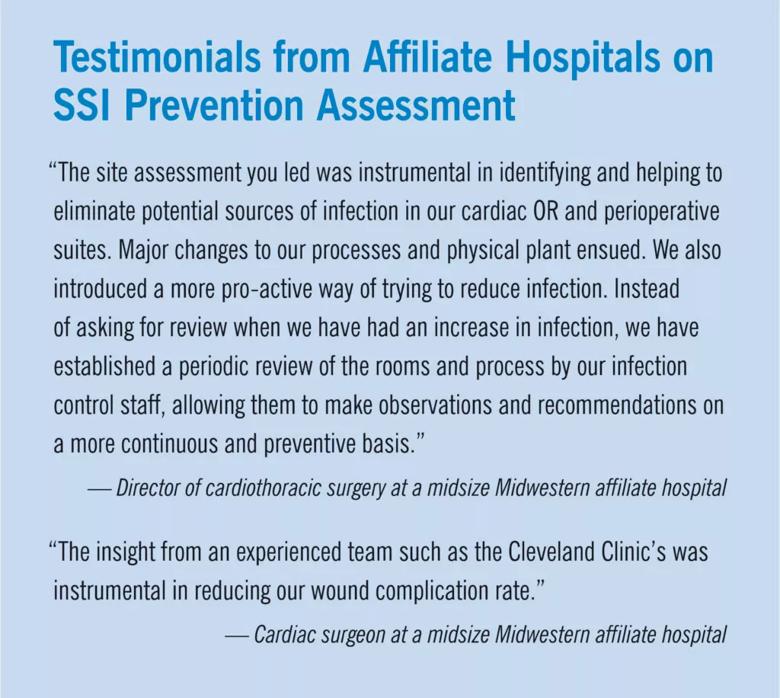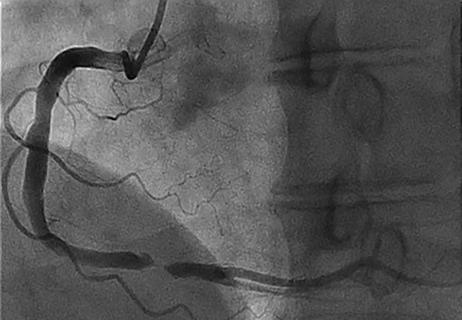How our Advisory Services and Affiliate Program has helped hospitals drive down SSI rates
Preventing hospital-acquired conditions is a priority for healthcare providers, as these conditions cause unexpected harm to patients and are often preventable. Surgical site infections (SSIs) are hospital-acquired conditions that increase morbidity, mortality and hospital readmissions. Therefore, focusing on reducing and eliminating their occurrence is critical for patient safety and outcomes.
Advertisement
Cleveland Clinic is a non-profit academic medical center. Advertising on our site helps support our mission. We do not endorse non-Cleveland Clinic products or services. Policy
SSIs account for 20% of all hospital-acquired infections and are associated with a twofold to elevenfold increase in the risk of mortality, with 75% of SSI-associated deaths directly attributable to the SSI.1 Furthermore, SSIs prolong hospital length of stay and have an adverse effect on patient-reported outcomes. Patients must be able to trust that hospitals will keep them safe while treating their medical conditions.
Prevention of SSIs — particularly deep sternal wound infections (DSWIs) — is one focus of the in-depth assessments offered to cardiovascular programs across the U.S. by the Advisory Services and Affiliate Program (ASAP) of Cleveland Clinic’s Heart, Vascular & Thoracic Institute. The ASAP team’s mission is to assist cardiovascular programs in improving their quality and operations in various areas. The team consists of physicians, nurses, a sonographer, quality and registry professionals, and continuous improvement and administrative experts who all have extensive experience in quality improvement, optimizing patient safety and continuous improvement.
Over the years, the Cleveland Clinic ASAP team has provided several hospitals with a comprehensive review and analysis of their SSI prevention efforts and detailed recommendations for reducing rates of DSWIs and other SSIs. These assessments have been highly successful in helping hospitals reduce their SSIs (Figure). This article outlines the importance of SSI prevention in cardiac surgery and how the ASAP team helps hospitals achieve it.
Advertisement

A DSWI is a devastating complication of cardiac surgery for the patient. It is also a challenging complication for hospitals and caregivers to treat. Additionally, hospitals are not reimbursed by the Centers for Medicare & Medicaid Services for costs associated with sternal wound infections, so these infections can have a negative financial impact.
The Society of Thoracic Surgeons (STS) defines a DSWI as an infection that meets the following criteria within 30 days postoperatively:
Overall, SSIs are the No. 1 hospital-acquired infection and cost the U.S. healthcare system an estimated $3.5 to $10 billion annually,2 with SSIs contributing the most (33.7%) to the overall costs of healthcare-associated infections.3 They also extend hospital length of stay by 9.7 days.1 SSIs are the leading cause of readmissions to the hospital following surgery, and approximately 3% of patients who develop an SSI will die as a consequence.4 The impact of SSIs on morbidity, mortality and cost of care has resulted in SSI reduction being identified as a top national priority in the U.S. Department of Health and Human Services Action Plan to Prevent Healthcare-Associated Infections.5
In cardiac surgery, the most prevalent reported SSIs involve the sternum and incision sites for harvesting saphenous veins and radial arteries.
Advertisement
Prevention of SSIs starts before surgery even begins. The ASAP team has found that when surgical programs develop standards of care, there may be gaps in knowledge related to perioperative management, insufficient protocols to promote infection prevention and lack of process validation for patient safety strategies. It is essential to make sure that all perioperative team members are properly educated in SSI prevention and that care delivery is informed by proactive attention to prevent SSIs.
Assessment by the ASAP team involves a site visit and includes the following:
The ASAP team has supported SSI assessments at several hospitals and identified modifiable opportunities at each institution. As part of the evaluation, the ASAP team consultants interview key stakeholders to gain perspective into current practices and challenges throughout the perioperative period. The project involves data analysis, a detailed assessment, real-time observations and evaluation of the cardiac surgical practice. The assessment is specifically focused on deep and superficial sternal wound infection prevention strategies, and it includes a comprehensive review of current clinical practice guidelines and protocols of each hospital’s cardiovascular surgical program.
Advertisement
The team identifies factors that contribute to DSWI. All contributing factors are evaluated. The team assesses adherence to evidence-based practice and registry recommendations. Patient profiles, cardiac procedure type and specific factors in the preoperative, intraoperative and postoperative phases of care are included in the analysis, which also looks at modifiable and nonmodifiable risk factors. Workflows and processes are evaluated and benchmarked to the hospital policy.
Once an assessment is completed, the ASAP team provides a comprehensive report of findings and recommendations that identifies opportunities and suggests modifications to current practices. Assessment findings have highlighted perioperative risk factors and protocol deficiencies that increase patients’ risk for infection. The ASAP team not only identifies these factors, but works closely with the perioperative teams to implement safeguards for infection prevention. The team’s report also gives guidance to help hospitals sustain their newly implemented processes and promote ongoing improvement.
“SSIs, and specifically DSWIs, are dreaded complications of cardiac surgery,” says Edward Soltesz, MD, MPH, Cleveland Clinic’s Director of Cardiac Surgery Affiliate and Alliance Programs. “While there is a trove of guidelines and best practices for preventing SSIs in cardiac surgery, individual surgical programs often struggle with adopting and operationalizing generalized recommendations. The ASAP team is unique in its personalized approach to each program, focusing on the individual program’s needs and unique circumstances. Rather than offering a generic set of recommendations, the ASAP team leverages its extensive experience to provide a site-specific set of recommendations and actionable steps for infection mitigation.”
Advertisement

1. National Healthcare Safety Network. Surgical Site Infection Event (SSI). January 2023. Available at: cdc.gov/nhsn/pdfs/pscmanual/9pscssicurrent.pdf.
2. Ban KA, Minei JP, Laronga C, et al. American College of Surgeons and Surgical Infection Society: Surgical site infection guidelines, 2016 update. J Am Coll Surg. 2017;224:59-74.
3. Zimlichman E, Henderson D, Tamir O, et al. Health care-associated Infections: a meta-analysis of costs and financial impact on the U.S. health care system. JAMA Intern Med. 2013;173:2039-2046.
4. Agency for Healthcare Research and Quality. Surgical Site Infections: Patient Safety Primer. January 2019. Available at: psnet.ahrq.gov/primers/primer/45/Surgical-Site-Infections.
5. Office of Infectious Disease and HIV/AIDS Policy, U.S. Department of Health & Human Services. National Action Plan to Prevent Health Care-Associated Infections: Road Map to Elimination. Available at: hhs.gov/oidp/topics/health-care-associated-infections/hai-action-plan/index.html.
For information on affiliation or alliance opportunities with Cleveland Clinic’s Heart, Vascular & Thoracic Institute, visit clevelandclinic.org/hvtiadvisoryservices or email Amanda Lesesky at leseska@ccf.org.
Advertisement

Launch of the tool promises to reshape quality assessment across the specialty

Robotic-Assisted Procedures Offer Breakthroughs in Lymphedema Treatment After Breast Cancer Surgery

Nursing leader highlights the interplay between provider transparency and better patient care

Why and how we’re using robotic assistance for qualifying CABG candidates

The case for a thoughtful approach to CTO and minimally invasive options for CABG

Perioperative nurses jumpstart careers by mastering specialty clinical practices

Preoperative Impella 5.5 placement can provide a critical safety net for high-risk patients

Cleveland Clinic study points to need for new strategies to curb addiction relapse